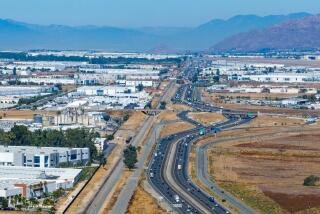Downey Offers Expanded Redevelopment Plans
- Share via
DOWNEY — The city this week took a key step in its bid to more than triple Downey’s redevelopment district. The vote comes as the city appeals a Superior Court ruling that invalidated its previous expansion of the redevelopment district.
The Downey Community Development Commission on Tuesday voted 3 to 0 with one abstention to send to city and county taxing agencies a plan to expand by 305 acres Downey’s 125-acre redevelopment district along Firestone Boulevard. The City Council doubles as the Community Development Commission.
The city also will forward plans to create a separate redevelopment district, called the Woodruff Industrial Project, in an 118-acre industrial area along Woodruff Avenue south of Firestone Boulevard.
In addition to the taxing agencies, the city’s Project Area Committee, which includes local residents and businessmen, will receive the documents outlining the so-called Amendment 4, which would expand the existing 125-acre redevelopment district. Because no residences are involved in the Woodruff Industrial Project, review by a PAC is not required.
Boundaries Seen by July
The new redevelopment boundaries could be in place by mid-July, city officials said.
Meanwhile, a spokesman for Downey CARES said the group of property owners in the Firestone area will fight the two plans, which would give the city condemnation powers for 12 years.
Owner-occupied residential property would be exempt, but once the original owner leaves the property, it also is subject to condemnation.
“There’s not one square inch of land in Downey that needs to be condemned,” said Michael Sullivan, president of Downey CARES, which fought the effort to expand the redevelopment district in 1984. “There is (independent) development going on in the city and that (condemnation) is a power City Hall doesn’t need.”
As proposed, the amendment area would include 305 acres both north and south of Firestone Boulevard, from Old River School Road on the west to the city line on the east.
Land use in the area is mixed with commercial and industrial uses accounting for 34% of the area. There are 168 single-family homes and multifamily structures in the original redevelopment area and the proposed addition, said Jim Cutts, director of community development.
In contrast, the area in the proposed Woodruff Industrial Project is 74.6% industrial and includes no residences.
Santangelo Abstains
Councilmen Randy Barb, Bob Cormack and Roy Paul voted to distribute the plan, while Mayor James Santangelo abstained. Councilwoman Diane Boggs was absent.
Taxing agencies, including the Downey Unified School District and the county Flood Control District, will review the plans to determine if creation of the redevelopment area will create a hardship by reducing future revenue.
Santangelo cast the deciding vote in July, 1984, when the City Council added 380 acres to Downey’s redevelopment district.
Downey CARES sued and a Superior Court judge invalidated the action in 1985, finding that Santangelo, who owned property in the original and added redevelopment areas, had a conflict of interest in violation of state law.
Downey has appealed the decision, and Santangelo faces trial in May on a misdemeanor conflict-of-interest charge. Santangelo, a real estate agent, sold his property in the contested area, but his real estate office is in the original district.
“Anything to do with any redevelopment plan that I have the advice of the city attorney to abstain from, I plan to do so,” Santangelo said after the vote, declining further comment.
When a redevelopment district is created, property taxes used to support traditional government services are frozen. Additional tax revenue generated from the higher value of redeveloped properties is then diverted to the redevelopment agency.
The city uses those funds to promote further redevelopment, including public improvements, and to pay off debts incurred through past redevelopment efforts.
Downey expects to draw about $500,000 in redevelopment revenue this year from property in the original district, said Lee Powell, Downey’s director of administrative services.
21% Gains in Value
Property in the original area has increased in value an average of 21% annually since the district was established in 1978, yielding more redevelopment revenue each year, according to the redevelopment report.
By amending the existing plan rather than creating a new project along Firestone Boulevard, the city would be able to use revenue generated from the added area to pay off the debts it incurred from the original district. The Community Development Agency is $5.9 million in debt, Powell said.
It also will allow the agency to borrow more money. The agency borrows money or issues bonds based on estimated redevelopment revenue and the cost to the city of developing the district. The commission can assume $15.5 million in debts for the original area, while the amendment will increase its borrowing limit to $60 million, according to the report.
The city may assume $20 million in debts for the Woodruff Industrial Project, according to the report.
More to Read
Sign up for Essential California
The most important California stories and recommendations in your inbox every morning.
You may occasionally receive promotional content from the Los Angeles Times.





![Vista, California-Apri 2, 2025-Hours after undergoing dental surgery a 9-year-old girl was found unresponsive in her home, officials are investigating what caused her death. On March 18, Silvanna Moreno was placed under anesthesia for a dental surgery at Dreamtime Dentistry, a dental facility that "strive[s] to be the premier office for sedation dentistry in Vitsa, CA. (Google Maps)](https://ca-times.brightspotcdn.com/dims4/default/07a58b2/2147483647/strip/true/crop/2016x1344+29+0/resize/840x560!/quality/75/?url=https%3A%2F%2Fcalifornia-times-brightspot.s3.amazonaws.com%2F78%2Ffd%2F9bbf9b62489fa209f9c67df2e472%2Fla-me-dreamtime-dentist-01.jpg)







